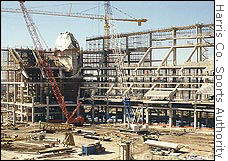
NEW YORK (CNN/Money) - Elected officials in Houston are betting billions in tax money on that famous movie promise: If you build it they will come.
Three new pro sports venues have opened up there in the last six years, costing a total of $900 million to build, with three-quarters coming from tax revenues. Interest on bonds will take the public contribution to about $2.3 billion at the end of the day.
That's quite a pile when you consider that, combined, the three teams playing in the stadiums contributed about $135 million upfront, and pay annual rent about $20 million, $22 million if you count what the rodeo will contribute.
Houston officials have lauded the city's edifice complex as a sign of their forward-thinking public vision. But, in fact, the deals may mark the end of a decade-long spiral of sweetheart deals for team owners.
 |
|
| Three new stadiums in Houston have cost about $1 billion, with taxes covering three quarters of the cost. |
Officials in other communities are learning to just say no.
"It is more difficult to get public funds for sports facilities," said Marc Ganis, a sports marketing executive who worked on a new home for the New Jersey Devils and New Jersey Nets. "State and local budgets are strained, services are being cut, taxes are being raised."
Only about 16 percent of the money for a new St. Louis baseball stadium will come from public sources, for example. Two reigning champions � baseball's Florida Marlins and hockey's Devils � have not been able to land new homes at all.
One reason local governments in the past had been willing to pay was to prevent some other government luring a team away. "With the expansion and relocation that has occurred," said Ganis, "there are fewer markets that are hungry for -- and can afford -- a professional sports franchise."
Big bucks for big events
Officials in Houston insist they made a good investment. The football stadium allowed them to win the NFL's 2002 expansion franchise, beating out Los Angeles.
| SportsBiz
|

|
| Click here for SI.com sports coverage
|
|
|
|
They also argue the new facilities will make the city more of a vacation destination, not just a place visited by business travelers. The facilities will let the city host this year's Super Bowl and baseball's All-Star game, as well as the 2011 NCAA Final Four.
"There is no city in America that can afford to buy the exposure that will take place during those three events," said Jordy Tollett, president of the Greater Houston Convention and Visitors Bureau. "People are going to see Houston in a way they've never seen it before."
But other cities are now questioning the value of the new stadiums and arenas.
In November, the Milwaukee Brewers announced they would slash payroll next year, their fourth season in the $400 million Miller Park.
| Related columns
|

|
|
|
|
Fans and state legislators were irate. After all, more than three-quarters of the funding for the team's fancy stadium came from a five-county sales tax -- which politicians said was enacted based on the team's promise that a new home would allow them to field a competitive team.
"The Brewers entered into a bargain with the taxpaying public," two leading Wisconsin legislators wrote in a letter demanding a public audit of the team's books. "Recent events have significantly eroded public confidence in the ability and even willingness of the team ownership to live up to its part of the bargain."
Tide has turned?
Nearly $20 billion has been spent to build or renovate 82 North American sports facilities since 1990, according to Shawn McCarthy, director the League of Fans, a public interest watchdog. About two-thirds of that money has come from public sources.
McCarthy thinks that the signing of blank checks may be a thing of the past. "There's pressure being put on city and state governments to take a harder look at these things," he said. "I think the tide has turned."
That doesn't mean that there won't be proposals across the land for new spending. The New York Jets are looking for $600 million in public funding for a new football stadium on the west side of Manhattan. The stadium would be used for the 10 days a year the Jets plays, plus the two-week 2012 Olympics should New York win its bid.
Forcing teams to pay a bigger share of the stadium cost themselves means less lavish stadiums in the future, another positive for sports. The Jets, for example, have offered to pay $800 million on top of the proposed taxpayer contribution.
This year's Super Bowl broadcast will no doubt lavish attention on the fancy Houston digs in which it is to played. But don't expect many future venues to be modeled after Reliant Stadium.
Some sanity finally seems to be present in the debate on new stadium construction. It's not only about time, it's long past time.

|

